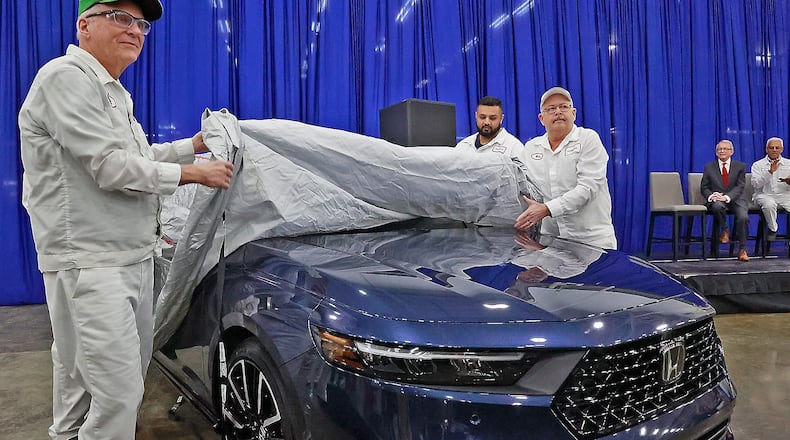The move is not expected to reduce Honda employment in the Buckeye State, a spokesman for Honda said. The change to EVs is going to be gradual, so the automaker expects to maintain employment across all locations during “key next steps in this transition,” the spokesman said.
“We are pursuing electrification based on our commitment to achieve carbon neutrality by 2050 and we think our strategy is a smart one which, in the near term, increases our sales of hybrid-electric vehicles and SUVs, to capture customers who will move with us into EVs in the coming years,” Honda spokesman Chris Abbruzzese said. “Also, we are steadily, but smartly, transitioning production lines in North America to build EVs and prepare for production of new electrified power units as well.”
The move ends four decades of Accord production in Ohio.
The company expects to use attrition “to manage any workforce changes that occur over time,” he added.
Before the pandemic, Honda was noted for never laying off a full-time employee in Ohio.
Production of the Accord will transfer to Honda’s Indiana auto plant in Greensburg in 2025, the company said.
This will maintain production volume of a core model, while enabling the Marysville plant, where Accord production had been situated, to transition to EV production, Honda said.
Additionally, the Anna engine plant will transfer component production for two generations of engines to another engine plant in Alabama.
Machining of the engine head for an existing V6 engine that powers many Honda light trucks will be added to Alabama operations starting this month.
Engine block casting for a new V6 engine in the 2023 Pilot will move to Alabama in August.
These two moves will allow Anna “to re-allocate space for future IPU Case production,” the company said.
These cases will be combined with the battery modules produced at the new joint venture battery facility Honda is building in Ohio with LG Energy Solution in Fayette County.
Those batteries will be used to power the EVs produced at the Marysville and East Liberty assembly plants, Honda said.
Last October, Honda announced that it would invest $700 million to retool several existing assembly and powertrain plants to establish the new EV hub, to prepare for the production of battery electric vehicles in 2026.
Honda also plans to dedicate a production line in Georgia to e-axle production, an component of EVs.
The Marysville plant, where Honda began auto production in America in 1982, will be Honda’s first auto plant in the U.S. to transition to making EVs.
Ohio will not be left without internal combustion engine automobiles, at least not completely. In addition to the Accord, Honda also produces the Acura TLX and Acura Integra at Marysville, and at the East Liberty Plant, Honda produces Honda CR-V and CR-V hybrid and Acura MDX and RDX.
Honda “will have more to share about the details of our retooling efforts and any change to the model lineup at MAP (Marysville Auto Plant) at the appropriate time,” Abbruzzese said.
Last month, leaders from Honda and LG Energy Solution broke ground for an EV battery plant in Fayette County’s Jefferson Twp., representing $3.5 billion of an overall projected $4.4 billion investment in EVs.
The plant will employ about 2,200 workers. It will be an approximately 50-minute drive southeast of Dayton, about 40 minutes south of Springfield and about 70 minutes east of Hamilton. The joint venture leaders expect to draw workers from those communities and others.
“As part of its goal to achieve carbon neutrality for all products and corporate activities by 2050, Honda has a vision to make battery-electric and fuel cell electric vehicles represent 100% of its vehicle sales by 2040,” Honda said in a statement. “Even as Honda accelerates preparation for EV production, the company plans to sustain current ICE (internal combustion engine) and hybrid-electric vehicle production in order to continue to meet anticipated strong customer demand through 2030 and beyond.
“The sustained success of ICE and hybrid-electric vehicle sales also will support the required investment in the electrified future,” Honda said.
About the Author

